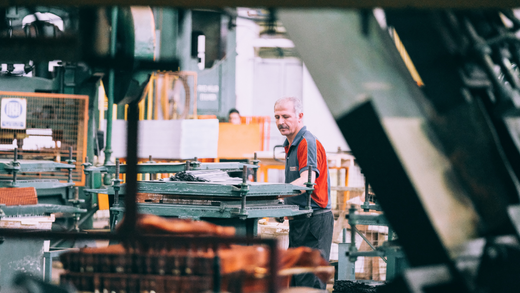How long do anti-fatigue mats last? PVC foam mats last 6-12 months. PVC/nitrile blends last 1-3 years. 100% nitrile mats have a life expectancy of up to 8 years.
That's the short answer. The extended answer is that life expectancy is complicated and too often ambiguous. What's clear is that it's a problem; from our survey of safety and production leaders, 52% expect their anti-fatigue mats to last at least 2 years – only 32% say they actually are. Why? There's a lack of clarity.
Below, 4 reasons your anti-fatigue mats aren't lasting including steps to make sure you have a complete understanding of lifespan before investing.

We surveyed 70 safety leaders, production managers, and manufacturing engineers. Sixty-eight percent say their mats aren't lasting the promised lifespan, a major problem in the anti-fatigue mat industry today.
1. Ambiguity on what life expectancy means
Say you recently purchased a premium ergo mat with a lifespan of 5+ years, but there is no literature clarifying what lifespan really means. It may mean cushion only. If the mat starts to curl in 3 months, creating a clear trip hazard, that's the end of its useful life.
Action step:
Always get clarity on what life expectancy actually means before hitting the buy button. For example, does "2 years" mean 2 years in an 8:00-5:00pm Monday-Friday facility, or 2 years in a 24/7/365 facility? The difference is thousands of hours of use for your team.
Ask mat providers directly and keep digging until you get clarity.

100% nitrile rubber foam, the material to make AcroMat mats, lasts for ~5 years in the toughest industrial settings. In less intense environments, like an office or retail setting, 100% nitrile will last 10+ years without interruption. Pure nitrile is unique in that it never flattens or loses its ergonomic cushion.
Related: 6 Reasons Companies Choose AcroMat Mats
2. Ambiguous warranties
Every anti-fatigue mat should have a warranty, one that is clear on what you are protected from and what happens if the mat doesn't work as promised. Be weary of "lifetime limited" and "manufacturing guarantees" that lack additional context. Most often, these don't promise anything more than "The mat will be made correctly."
Before purchasing an anti-fatigue mat, you should know with certainty what you're being protected against.
- Your mats will NEVER curl along the borders
- Your mats will NEVER sink, flatten, or lose their ergonomic cushion
These performance protections are part of the AcroMat Lifetime Performance Warranty. If our mats were to fail, we replace them immediately. No easy outs of ambiguity. Unfortunately, too many many warranties give suppliers the ability to say "sorry, not our problem" as soon as you unbox your mats.
Action step: Read the warranty fine print, then ask for clarity if it's still ambiguous.

Under the AcroMat Lifetime Performance Warranty, all 100-Series mats are guaranteed to remain permanently resilient and never sink, flatten, or lose their ergonomic cushion. They are also guaranteed to never curl, eliminating a dangerous trip hazard.
3. Biased product pages
If you see "SpongeCell3000," "exclusive nitrile blended foam" or some other confusing, fancy name for the mat materials you're considering, the mat is most likely made from a combination of nitrile rubber foam and PVC foam. Skip the marketing language and find the technical specifications.
This is the most common blend of materials used on the marked today. It's comfortable and versatile, but struggles in more intense environments.
For example, mats with a percentage of PVC foam are open cell and not impervious to liquids and chemicals. In environments with any kind of spill or splash, PVC foam or PVC foam blends will absorb the liquids and, in turn, crack, curl, flatten, and erode more quickly than closed cell, chemical resistant mats. and going flat.
Conversely, 100% nitrile (no PVC foam component) is impervious to liquids and chemicals; it's literally incapable of absorbing any liquid product.
We soaked 100% nitrile in water for 72 hours to see if it would absorb liquids. Here are the results.
Action step:
Skip the promotional language from a product page, and just directly to the technical specifications (specs), warranty and FAQ. Always be sure to ask for a free sample, and test the mat in your environment for weeks if not months.
 PVC foam mats last 6-12 months. PVC/nitrile blends last 1-3 years. 100% nitrile mats have a life expectancy of up to 8 years
PVC foam mats last 6-12 months. PVC/nitrile blends last 1-3 years. 100% nitrile mats have a life expectancy of up to 8 years
Related: The 100% Nitrile Difference
4. Lack of independent certification
Independent testing and certification provides critical objectivity. It also gives you control during the research and buying process; you're relying on objective assessments rather than promises or promotions by the company.
When sampling or trialing anti-fatigue mats, you can refer back to certifications to help gain guy-in from leadership.
Example 1.
The AcroMat 100-Cleanroom Series mat was independently tested for 500 hours to receive ISO-5 cleanroom Certification. Certification details.
Example 2.
The AcroMat 100-Series and NitriTuf Diamond Series is "High Traction" certified by the National Floor Safety Institute. NFSI is the nationally recognized standard for measuring an ergo mat's slip resistance. According to NFSI, "high traction" certification has proven to reduce wet-slip risks by 50-90%. Certification details.
Action step:
Review certifications and the testing results. Certifications shouldn't be the end all, but understanding what they represent can help you make more informed decisions.
How long anti-fatigue mats last ultimately depends on the durability of the materials, whether they're right for your particular environment, and how you use the mats. The simple steps above, like asking pointed questions and make sure you put samples to the test in your working setting, can provide you with a better understanding of what to expect from your mats.





